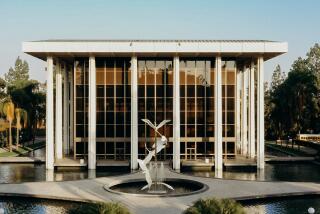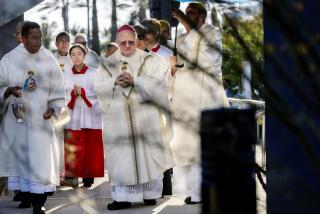Crystal Cathedral sale to diocese a milestone; some see a miracle
Whenever clergy from Asia, South America or Europe visit Roman Catholic Bishop Tod Brown in Orange County, they all want to see one church, but not one of Brown’s. They want to see the Crystal Cathedral.
For decades, the architectural landmark — famous for its 10,000 panes of glass and 236-foot bell tower — has been synonymous with the Rev. Robert H. Schuller and his “Hour of Power” broadcasts. That is about to change.
Last month, the Crystal Cathedral property became the future home of the diocese after a bankruptcy judge approved the sale for $57.5 million. The Vatican has signed off and diocese officials expect escrow to open soon.
In Orange County, where a third of the population is Catholic, the deal represents both vast demographic change and the rising influence of the church.
“I think the Crystal Cathedral will be, for us, the heart and center for our Catholic community,” said Brown, who reached the mandatory retirement age of 75 on Nov. 15, two days before the court victory. He will help oversee the transition because a successor has not yet been named.
Such cooperation between Catholic and Protestant faiths was once unimaginable in American Christianity.
In a rare interview, Schuller told The Times that he never saw it that way.
“I think it could have happened 20 years ago because I haven’t changed,” he said. “It’s who I have always been.”
The 85-year-old minister, who became the pivotal unifying force in the bankruptcy sale, said he has always respected the Roman Catholic faith and considers it the “mother church.” Schuller also said he drew inspiration for his “Hour of Power” from Catholic Archbishop Fulton J. Sheen, whose own popular TV show in the 1950s paved the way.
“The Roman Catholic Church isn’t going to change its theologies,” Schuller said. “I trust them.”
Still, Brown’s tenacious pursuit of one of the most recognizable Protestant symbols surprised many, even Brown himself, who said the idea “never crossed my mind” until several lay advisors approached him. After all, he had long planned to build a cathedral in Santa Ana for an estimated $200 million in response to the booming Catholic population. He even hired an architect last year.
But he quickly saw the bankruptcy as a chance to fulfill his dream in a different way and began a bidding war for the church property with Chapman University.
In the final 24 hours, Brown said that even he thought “it was all over.” Then Schuller, who had won over millions of believers through his credo of “possibility thinking,” told the court he could not abide the thought that Chapman might someday use the cathedral for nonreligious purposes. The deal was struck.
Diocesan officials were elated, with one attorney calling it a miracle. As Brown put it, “ecumenism has got a shot in the arm.”
The acquisition unquestionably raises the profile of the nation’s 10th-largest Roman Catholic diocese and could help it emerge from the shadow of the Los Angeles Archdiocese.
“It was a tactical decision,” said Father Thomas Rausch, a professor of Catholic theology at Loyola Marymount University. “Here’s this beautiful church with a rich history in Orange County and an identity that’s already established. It’s a bargain for the local church.”
It was a bittersweet victory, though, because Brown knew it marked the end of an era for Schuller’s world-famous Crystal Cathedral Ministries, which has three years to vacate under terms of the deal, whereupon the Catholic diocese will use the campus.
Sheila Schuller Coleman, the founder’s daughter, is senior pastor and continues to preach “possibility thinking,” though the philosophy has not brought the $50 million in donations that could have staved off a sale.
“There’s plenty of time for God to perform a miracle,” she told congregants on a recent Sunday. At the front of the church, a table was set up with sign-up sheets for a “miracle” prayer drive.
Congregant Jillian Carter of Torrance said she still holds out hope.
“I feel like it’s not over until it’s over. Anything can happen,” she said. “This place has its trademark. Nobody can take that.”
That trademark is exactly what appealed to the diocese.
When Brown succeeded Bishop Norman McFarland in 1998, there were 600,000 Catholics in Orange County. There are now 1.2 million. That growth can be seen on almost any Sunday. For many parishes, the norm is standing-room-only turnout for Mass; at others, the Sunday crowds spill out the doors. Mass is said in 10 languages, including Vietnamese, Polish, Mandarin, Korean, Indonesian and Spanish.
During Brown’s tenure, he dedicated nine churches, bringing the diocese total to 57. He also appointed Latinos and women to key positions and gave a new parish a Vietnamese name, Our Lady of La Vang, a first for a Catholic church in Southern California.
But he never lost sight of building a cathedral, first announcing plans in 2001.
Barbara Nelson, executive director of a Santa Ana shelter for pregnant teenagers, remembers working on the capital campaign for the cathedral from 2000 to 2002. Brown went to her office days before the formal kickoff, she said, and told her it was “inappropriate” to move forward given the clergy sex-abuse scandal that was facing the diocese.
“We had the brochures printed and everything,” she said.
The scandal became his priority.
In January 2004, Brown nailed a “Covenant with the Faithful” to the doors of Holy Family Cathedral, a seven-point promise to heal wounds and foster trust within the diocese.
One year later, he became the first bishop to settle all of the abuse cases in his diocese with a landmark $100-million payout to 87 claimants, an average of $1.1 million per plaintiff. The decision not to go to trial placed Brown as a leader in the settlement movement; he also allowed sealed personnel files to go public.
That same year, he established Christ Our Savior parish and deemed it the site of the future cathedral.
But in 2007, Brown found himself under fire.
As part of a separate sex abuse lawsuit, Brown had been deposed. Although diocesan attorneys moved to seal that testimony, the judge allowed it to be read in court.
In it, Brown acknowledged that years before, he allowed a priest accused of raping a 15-year-old girl to work at a parish with an elementary school. “A lot of bishops, including myself, were not fully aware of the seriousness of the problem in terms of putting other people at risk,” Brown testified.
The deposition also revealed that Brown had been accused of molesting a boy early in his priesthood. Brown denied the allegation when it was lodged in 1997. An internal investigation determined the complaint to be baseless.
The lawsuit and three others facing the diocese were quickly settled for $6.8 million. But Brown then faced contempt of court proceedings, accused of violating the judge’s orders for allowing a church official who was to testify to leave the country. The citation was later dropped as part of the settlement.
Through it all, Christ Our Savior, the expected future home of a new cathedral, flourished. The parish once celebrated Mass in a multipurpose room. Now, five Sunday services are held in large modular units resting on concrete slabs. The parish will go on, just not with a grand cathedral.
“I am a little disappointed because I was going to be part of the parish that would be the new cathedral,” Nelson said. “But on the other side of the equation, it makes so much sense.”
Jeff Urbaniec, chairman of the Diocesan Council and a member of the Pastoral Council for Christ Our Savior, sees possibilities.
“I think, over time there’s been a sense of opening up to the idea that we perhaps have a lot more in common than perhaps we realize,” he said. “I think we could have a coming together of different faiths and a better understanding of each other.”
Not everyone is happy, though.
Amin David, who owns a plumbing supply company in Anaheim, said his family is “disquieted” by the money involved.
Almost two years ago, David’s grandson had to switch middle schools because the school at Saint Anthony Claret in Anaheim had closed, he said. And St. Boniface, also in Anaheim, closed its school in 2006.
“This is not the right time to be making these huge outlays,” David said. “It just doesn’t sit well with my family. We don’t remember being asked what we think about it.”
Mark Buckles, a parishioner at Holy Family, is among those who wanted a cathedral built from the “ground up,” as he put it.
And making the Crystal Cathedral iconic for the Catholic community won’t be easy, he said.
“It will be up to the new bishop to make this a reality,” said Buckles, 60. “Winning the bid was the easy part.”
Father Al Baca, Brown’s chief ecumenical officer, said Christian leaders — including Orange County-based evangelist Rick Warren — praised the deal, and were praying for it to go through.
“These are the kind of things that maybe 25 years ago would have been impossible,” he said.
Brown doesn’t disagree.
“This was an incredible surprise,” he said. “For us, it was certainly the work of a minor miracle.”
As for Schuller, what he built in Garden Grove is not about him, he said, but about faith.
“I know when I called it the Crystal Cathedral, they said it’s not a cathedral. And I said, ‘not yet.’ It wasn’t yet, but it has become one.”
More to Read
Sign up for Essential California
The most important California stories and recommendations in your inbox every morning.
You may occasionally receive promotional content from the Los Angeles Times.











